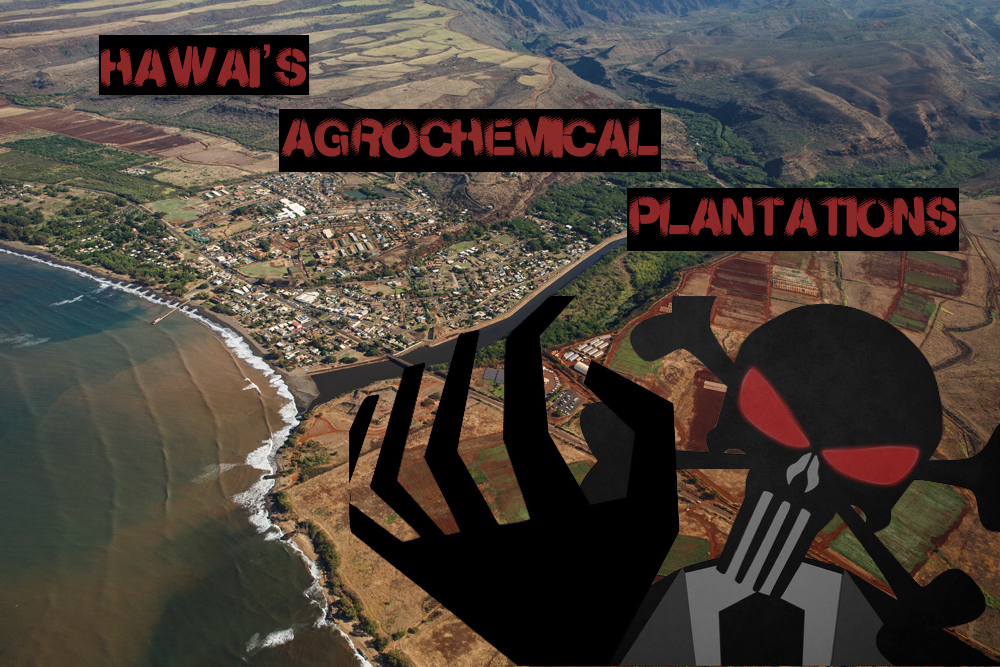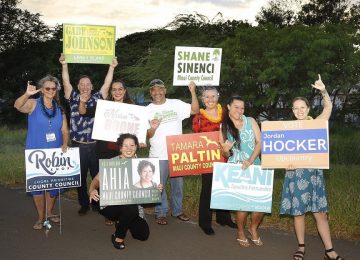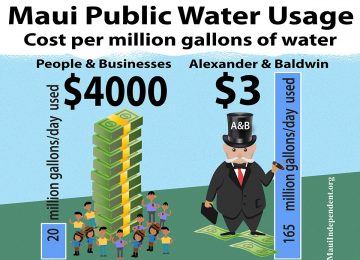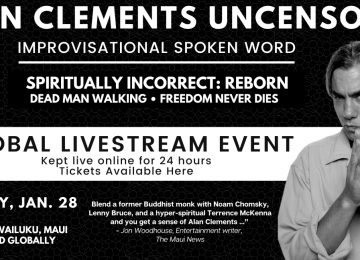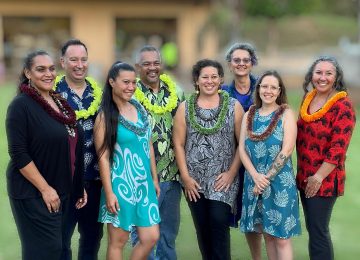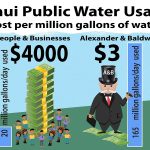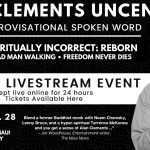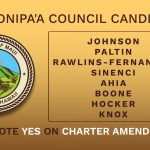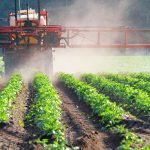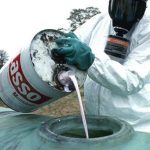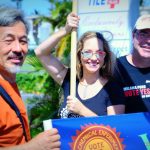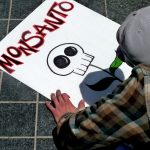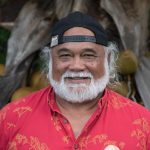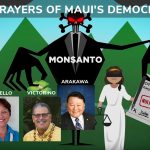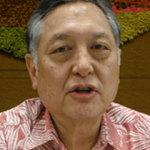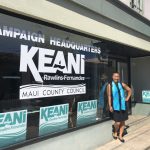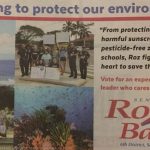A brilliant new doctoral thesis by Kauai native Andrea Brower reveals the first comprehensive analysis of how Hawai’i’s historically exploitative plantation system has morphed into the ecologically exploitative “agrochemical-seed-biotechnology industry’s occupation of Hawai’i.”
Brower’s 314 page doctoral thesis, titled, “Hawai’i: GMO Ground Zero,” contributes what she frames as a, “previously absent critical analysis of Monsanto, Dow, DuPont, Syngenta, and BASF’s occupation of Hawai’i. It details the political, social, historical, and geographical arrangements that give rise to the situation, with focus especially on matters of capital, expropriation of the commons, imperialism, and capitalist state functioning.”
A PhD graduate from the Department of Sociology at New Zealand’s University of Auckland, Brower has been active in alternative food and global social justice movements, and spent several years co-directing the non-profit Malama Kauai. Exposing how the State of Hawai’i has sold out to the biotech giants who preside over more than 1,000 GMO test farms across the Hawai’i, her damning indictment pays particular attention to the island of Kaua’i. “Hawai‘i,” Brower writes, “is placed at the epicenter of the agrochemical-seed-biotech oligopoly’s global chains of production.”

Brower explains: “The popular press, economic reports, and legal and state documents conclude simply that the industry operates in the islands because of good weather. This smooth narration obscures fundamental socio-political and historical context. Hawai’i’s place “within,” as a colony of, the United States, but isolated and sub-tropical, is core to agrochemical-seed-biotech companies’ decisions to locate in the islands.”
Describing how “Monsanto and gang’s operations have established in the tracts of Hawai’i’s plantation oligarchy past, directly inheriting infrastructures, institutions, and ideas,” she suggests, “truly alternative possibilities require contesting core conditions that continue to facilitate plantations, monoeconomies, oligarchies, and oligopolies.”
Detailing the industry’s environmental destruction in the islands she notes: “From a class-action lawsuit on Kaua’i, it was divulged that when general-use pesticides (GUP) are accounted for, at least 90 pesticide formulations with 63 different active ingredients were used by DuPont between 2007-2012, and that pesticides were applied 250-300 days per year, at an average of 10-16 applications per day (Jervis and Smith 2013).”
“Pesticides are often “stacked,” or mixed into cocktails with more harmful and almost entirely untested and unregulated synergistic effects (Vallianatos 2014). This usage of combinations of an “ever-changing kaleidoscope of pesticides,” as described by Sandra Steingraber, is of particular concern (2016, 2). For example, a recent review of the scientific literature indicated that the cumulative effects of individual non-carcinogenic chemicals “acting on different pathways, and a variety of related systems, organs, tissues and cells could plausibly conspire to produce carcinogenic synergies” (Goodson et al. 2015, S258).”
The resulting pesticide saturation has likely created major health issues she suggests. “Numerous local doctors have submitted official statements expressing concern that they may be witnessing effects of pesticide exposure in communities living near fields, potentially including higher than average rates of rare birth defects, miscarriages, unusual cancers, respiratory and hormonal problems, and recurring dermatitis and nose-bleeds (public testimony, Kaua’i Bill 2491).”
None of this could have happened without State collusion and corruption. “The dominant idea that transnational agribusiness which exports its wealth from the islands is the only economic form that can “feed our families” and offer realistic diversification to tourism assumes and obscures numerous forms of public subsidization, particular arrangements of resource control and power, and government facilitation of not only private sector profits, but product monopolies and corporate dominance.”
“For capitalist plantation agriculture to become the established norm in Hawai‘i and displace the sophisticated production systems that preceded it, it took both imperial nations enforcing their commercial demands on the islands and the backing of a local state.”
“Without favorable local land, water, forest, labor, infrastructure, tax, and trade policies, sugar could not have been competitive or profitable on the global market.”
“Similarly, contra the oft-repeated assertion that agrochemical industry contributions…are at no cost to the State” (Loudat and Kasturi 2013, 4), their operations are conditioned upon a range of public supports and subsidies, including policies that enable externalization of health and environmental costs onto the public. Much of this support is in the foundation of a plantation past, with sugar’s legacies continuing to facilitate the new agribusiness barons.”
“In addition to public land and water, agrochemical companies are directly subsidized through property tax breaks, high-technology tax credits, investment capital, and taxpayer loss of general excise tax revenue (Kanehe 2014; Hooser 2015b; Redfeather 2012). In 1999, the state began offering various incentives to “high-technology industries” through the passage of Act 178, followed by Act 221 in 2001 and Act 215 in 2004. Act 178 contained eight initiatives with tax credits being its hallmark; these sunset in 2010. According to an audit in 2012, these high technology tax credits cost the state an estimated total USD $1 billion in lost tax revenue since 1999 (Higa 2012).”
“For most of the years these subsidies were in place, the names of the companies receiving them were not made public or revealed to the legislature, unlike in other states where disclosure is mandated (Curtis 2014; Higa 2012). Thus, it is impossible to know which of the agrochemical companies received subsidies and to what extent. Virtually none of the tax claims were audited (Higa 2012).”
Equally as shocking she reports how the biotech companies avoid paying state General Excise tax. “Unlike other forms of agricultural production in the islands, the seed development conducted by agrochemical companies does not generate a product that is then sold so excludes payment of general excise taxes. These are lost public revenues that have occurred with the transition from agricultural production to seed-biotechnology research and development (Bynum 2013).”
“Similarly, companies take advantage of agricultural property tax and utility subsidies from counties through land use dedication policy designed to incentivize agricultural production.”
She goes on to expose how public educational institutions in Hawai’i serve the GMO industry. “Of additional significance in regards to public supports is the role of research institutions, and especially the (University of Hawai’i’s) College of Tropical Agriculture and Human Resources, a public land grant institution. Instead of supporting local production and raising the percentage of homegrown food, CTAHR has increasingly devoted its resources to serving the interests of biotechnology.”
She references a 2015 Open Letter of Protest from more than 60 U.H. faculty claiming that the agriculture college has prioritized the interests of large out-of-state corporations over those of small local farmers. “At times, as many as 60 or 70 CTAHR faculty and staff have been working on biotech projects, despite the fact that, after the initial success of the Rainbow papaya, not one of CTAHR’s more than a dozen attempts to produce a commercially-viable genetically engineered plant species has proved successful… It is surely questionable whether, in terms of a land-grant institution’s mission, such corporations should be treated as members of “Hawai‘i’s food and agricultural system” at all.”
“Faculty within CTAHR who have been critical of the agrochemical industry or raised general questions about agricultural biotechnology have faced various forms of harassment, silencing, and restrictions of their research and academic freedom.”
CTAHR Professor Hector Valenzuela, who had developed a pioneering, long-term organic farming project, had his research shut down by the university, “around 1998, when Monsanto money began entering the equation.”
The State has also bowed down to the corporate giants by abdicating responsibility for monitoring the health of our citizens subject to pesticide exposure. “The State Department of Agriculture has granted exemptions to federal pesticide label requirements, including allowing pesticides to be used in higher wind speed conditions and increasing the frequency of allowable applications (HDOA 2015),” she points out.
“The ADC (Agribusiness Development Corporation) has facilitated exemption from compliance with Clean Water Act standards by “administratively extending” former sugar plantation’s National Pollutant Discharge Elimination System (NPDES) permit, which includes reporting and monitoring of pollutants in wastewater. An ADC memo recommended an exemption because the Clean Water Act criteria would “likely be extremely difficult to meet” as more stringent federal limits, including discharge limits for pesticides, are now in force (JFFG Draft 2016, 46-47).”
“When sugar and pineapple vacated the islands, the state did not require companies to clean-up pesticides or other contaminants. Likewise, as chemical companies drop leases on thousands of acres of public land, they are not responsible for soil remediation or for supplying tests to show that they have not left significant chemical contamination.”
Brower also notes: “The state has followed federal government in not requiring disclosure of the location of experimental biotechnology field trials, irrespective of their nature and legally and scientifically acknowledged potential impacts (Gibson 2014). In the words of Earthjustice attorney Paul Achitoff, the state merely acts as a “rubber stamp” regarding any federal decisions about GE crop trials (ibid, 242).
The biotech giants have done a brilliant job of conning people into believing they are saving the world through GMO seeds, and that they are caring stewards of Hawai’i’s land. Monsanto’s propaganda would have us believe: “We understand the responsibility we have to farm sustainably and to work collaboratively to promote a strong and successful Hawai’i agricultural industry.”
In harnessing public support for their actions, Brewer describes how the companies insidiously employ the language of non-exclusion as a propaganda tool. “These “together” count-as-one (Badiou 2005) operations especially employ the language of non-exclusion. The state’s hosting of an agricultural policy conference sponsored by Monsanto, Dow, and Coca-Cola is in support of “all agriculture,” a non-exclusion that necessarily excludes (NASDA 2015).”
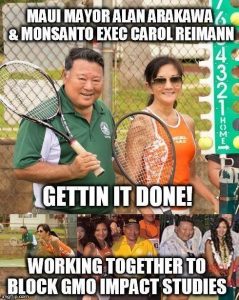
“Everything must be “supported” because “we are in this together,” and only “together” are “win-win” arrangements possible (Save Kaua‘i Farms 2013; Kaua‘i Mayor Bernard Carvalho in Cocke 2013d). To object to some element in the counted one of “local agriculture” is to be an enemy of inclusion, coexistence, harmony, and collaboration. To raise the inexistent — the already excluded, the divisions, structural inequalities, and universals — is to betray “Island style…in this together” (Farmers & Friends 2014, n.p.).”
Opponents of GMO seed production are routinely demonized and marginalized. “While agrochemical-seed-biotech corporations and their local operations are continually formulated as simply necessary (or at minimum, inevitable), concerns about their environmental and health consequences are disparaged as having no basis in fact or science, driven instead by emotion, fear, and politics (Von Mogel 2013). In contrast, the industry claims to offer a “science-based perspective.”
“A broad and heterogenous range of concerns are lumped into a singular and monolithic “scourge of paranoia,” comprised of subjects that warrant the unsavory characterizations of hysterical, fanatical, Luddite, paranoid, delusional, and conspiracy theorist (Conrow 2014a and 2015a; Harmon 2014; Kamiya 2014; Kloor 2012).”
“Anecdotal evidence of harm is said to be nothing more than a “scare tactic,” while citizens are incapable of literacy beyond “selected beliefs as claimed in Google searches” (KauaiEclectic blog comments). Casting certain affairs into the realm of the “complicated,” lay voices are said to be ignorant and uneducated, and only those with
specialized “expertise” are assumed to possess valid knowledge.”
In exposing how Hawaii’s politicians collude with the agrochemical industry Brower describes how, “there is a relative normalization of what in other places would be considered too intimate a relationship between regulators and the regulated.
As a Hawai‘i Senator put it, it is an “open secret” that key power-holders within state government, including the chairs of committees that control a majority of legislation related to agriculture, have a close relationship with the agrochemical industry (Pala 2015). This includes many individual legislators receiving tens of thousands of dollars annually just in direct campaign contributions from the industry (Grube 2014).”
“Previous Governor Neil Abercrombie (2010-2014), who himself was a primary beneficiary of industry funds, summarized this close relationship well in his proclamation to the industry (at the 2011 Hawaii Crop Improvement Association conference): ‘I’m here lobbying you… You don’t have to lobby me. You don’t have to lobby Russell (Kokubun, Department of Agriculture Chair). You don’t have to lobby this administration!”
References:
Badiou, A. 2005. Being and Event. Translated by Oliver Feltham. London: Continuum
Bynum, T. 2013. “2491 A Chance to Control Destiny.” The Garden Island. 29 September. http://thegardenisland.com/news/opinion/guest/a-chance-to-control-destiny/article_1f3a3742-28d4-11e3-960c-0019bb2963f4.html.
Conrow, J. 2015a. “Christopher Pala’s Hit Piece.” KauaiEclectic Blog. 23 August. https://kauaieclectic.blogspot.com/2015/08/musings-christopher-palas-hit-piece.
Curtis, H. 2014. “Launching a High Technology Industry in Hawaii.” Ililani Media. 19 May. http://ililanimedia.blogspot.co.nz/2014/05/launching-high-technology-industryin.html.
Farmers & Friends. 2014. “Our Mission.” http://farmersandfriends.org/our-mission/.
Gibson, D. 2014. Remembering the “Big Five”: Hawai’i’s Constitutional Obligation to Regulate the Genetic Engineering Industry. Asian-Pacific Law & Policy Journal, 15(2): 213-283.
Goodson et al. 2015, S258.” https://www.ncbi.nlm.nih.gov/pubmed/26106142
Grube, N. 2014. “Will the GMO Debate Fuel Campaign Donations as Local Elections Heat Up?” Civil Beat. 28 April. http://www.civilbeat.com/2014/04/21924-will-the-gmodebate-fuel-campaign-donations-as-local-elections-heat-up/.
Harmon, A. 2014. “A Lonely Quest for Facts on Genetically Modified Crops.” The New York Times. 4 January. http://www.nytimes.com/2014/01/05/us/on-hawaii-a-lonelyquest-for-facts-about-gmos.html?pagewanted=3&_r=1.
Hawaii Department of Agriculture (HDOA). 2015. “List of Active Special Local Need Registrations.” Posted 30 January. http://hdoa.hawaii.gov/pi/files/2013/01/Listof-Active-SLNs-By-SLN-Number-with-Labels_01302015.pdf.
Higa, M. 2012. Audit of the Department of Taxation’s Administrative Oversight of High-Technology Business Investment and Research Activities Tax Credits. Office of the Auditor, State of Hawaii, Report No. 12-05.
Hooser, G. 2015b. “Why I March For Aloha ‘Āina – Join Me Sunday August 9 on Oahu.” GaryHooser’s Blog. 8 https://garyhooser.wordpress.com/2015/08/08/why-i-march-for-aloha-aina-join-me-sunday-august-9-on-oahu/.
Jervis, G. and K. Smith. 2013. Presentation by plaintiffs’ attorneys in lawsuit by Waimea, Kaua’i residents against Pioneer, DuPont. 13 July. http://vimeo.com/70580803.
Kamiya, J. 2014. “The Bleeding of Aloha: Ugliness of the Anti-GMO Movement in Hawaii.” HawaiiFarmersDaughter. 15 October 2014. https://hawaiifarmersdaughter.com/2014/10/15/the-bleeding-of-aloha-ugliness-of-the-anti-gmo-movement-in-hawaii/.
Kanehe, L. 2014. “Kū‘ē Mana Māhele: The Hawaiian Movement to Resist Biocolonialism.” In Goodyear-Ka‘ōpua, N., Hussey, I. and Wright, E. (Eds.) A Nation Rising: Hawaiian Movements for Life, Land, and Sovereignty. North Carolina: Duke University Press. 331-353.
Loudat, T. and Kasturi, P. 2013. Hawai‘i’s Seed Crop Industry: Current and Potential Economic and Fiscal Contributions, 2013 edition. http://www.hciaonline.com/hawaiisseed-crop-industry-current-and-potential-economic-and-fiscal-contributions/.
Pala, C. 2015. “Pesticides in Paradise: Hawaii’s Spike in Birth Defects Puts Focus on GM Crops.” The Guardian, 23 August. http://www.theguardian.com/us-news/2015/aug/23/hawaii-birth-defects-pesticides-gmo.
Redfeather, N. 2012. GMOs in Hawai‘i – The Big Picture. In Black, C. (Ed.) Facing Hawaii’s Future. Koloa: Hawaii Seed. 25-27.
Save Kaua‘i Farms. 2013. “About.” http://savekauaifarms.com
Steingraber, S. 2016. Comment letter on draft report, Pesticide Use by Large Agribusiness on Kaua’i. 8 April 2016
Vallianatos, E. 2014. Poison Spring: The Secret History of Pollution and the EPA. New York: Bloomsbury Publishing.
Von Mogel, K. 2013. “Analysis of Kaua’i County Bill #2491.” Biology Fortified. 26 June. http://www.biofortified.org/2013/06/analysis-of-kauai-bill-2491/.



